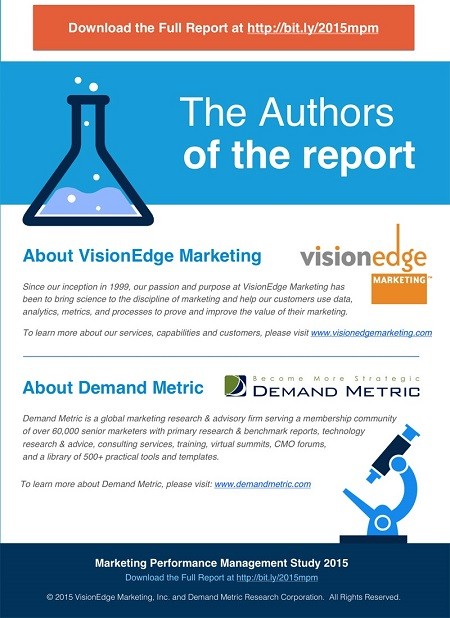The question the C-suite often asks of Marketing is this: "What have you done for us lately?"
Most marketers are facing constant scrutiny regarding their performance and contribution. Very few, however, are responding to it in a way that inspires confidence.
The 2015 Marketing Performance Management (MPM) Benchmark Study: A Diagnosis and Prescription for Marketing Performance Management, measured that pressure from the C-suite, finding that 83% of survey participants feel it.
But the way marketing organizations respond to that pressure differs significantly, and those differences are defining.
The The 14th annual MPM study study, conducted by VisionEdge Marketing and Demand Metric, highlights how some marketing organizations keep their seat at the corporate leadership table while others earn even greater credibility and influence. The research, capturing input from 374 respondents, provides insights on performance measurement as well as management challenges and best-practices.
A key component of the annual study is the grade that the C-Suite gives Marketing for its ability to prove its value. This year the distribution of grades is as follows:
- Just over 20% of marketers earned the highest grade, an A.
- 30% earned a B.
- Approximately half of the marketers earned a C or lower.
How to Earn an A
The study establishes that a marketing organization's grade strongly correlates to four areas:
- The priority or importance attached to measuring Marketing's value and contribution
- A well-defined and documented plan for improving performance management and business impact
- The alignment of Marketing to business outcomes that matter to the C-suite and the associated metrics.
- The operational working of the marketing function
Five Key Differences
The "Best-in-Class" (BIC) marketers exhibit five key differences that enable them to excel at marketing performance management:
- MPM is important enough to warrant a plan: Nearly twice as many BIC marketing organizations have a performance management plan compared with their "Laggard" colleagues.
- BIC Marketers aspire to serve as Centers of Excellence (CoE): The BIC group is five times more likely to operate as a CoE than are Laggards.
- Business acumen: The BIC group is two times more likely to have knowledge of the core business.
- Customer knowledge: The BIC group is five times more likely to use data in an effort to understand and market to customers. For example, only 10%t of the Laggards claim to effectively understand the customer experience based on data, compared with nearly 50% of the BIC group.
- Utilization of data: Although many marketing organizations have access to data and analytics, the real difference is in usage. Compared with the Laggards, the BIC Group is nearly two times more likely to use data and analytics to make strategic decisions and recommendations.
(For more from the VEM and Demand Metric study, join the free webinar on Wednesday, April 29, at 9 AM (Eastern), "How Best-in-Class Marketers are Outdistancing the Pack.")
The following infographic shares some of study highlights:







